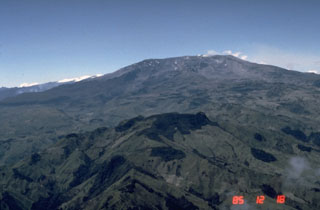Report on Nevado del Ruiz (Colombia) — 18 March-24 March 2020
Smithsonian Institution / US Geological Survey
Weekly Volcanic Activity Report, 18 March-24 March 2020
Managing Editor: Sally Sennert.
Please cite this report as:
Global Volcanism Program, 2020. Report on Nevado del Ruiz (Colombia) (Sennert, S, ed.). Weekly Volcanic Activity Report, 18 March-24 March 2020. Smithsonian Institution and US Geological Survey.
Nevado del Ruiz
Colombia
4.892°N, 75.324°W; summit elev. 5279 m
All times are local (unless otherwise noted)
Servicio Geológico Colombiano’s (SGC) Observatorio Vulcanológico y Sismológico de Manizales reported that small and periodic ash-and-gas emissions from Nevado del Ruiz were visible in satellite and webcam images during 18-24 March. These emissions drifted NE and SE. A gas-and-steam plume rose 1.5 km above the crater rim on 23 March. The Alert Level remained at 3 (Yellow; the second lowest level on a four-color scale).
Geological Summary. Nevado del Ruiz is a broad, glacier-covered volcano in central Colombia that covers more than 200 km2. Three major edifices, composed of andesitic and dacitic lavas and andesitic pyroclastics, have been constructed since the beginning of the Pleistocene. The modern cone consists of a broad cluster of lava domes built within the caldera of an older edifice. The 1-km-wide, 240-m-deep Arenas crater occupies the summit. The prominent La Olleta pyroclastic cone located on the SW flank may also have been active in historical time. Steep headwalls of massive landslides cut the flanks. Melting of its summit icecap during historical eruptions, which date back to the 16th century, has resulted in devastating lahars, including one in 1985 that was South America's deadliest eruption.

